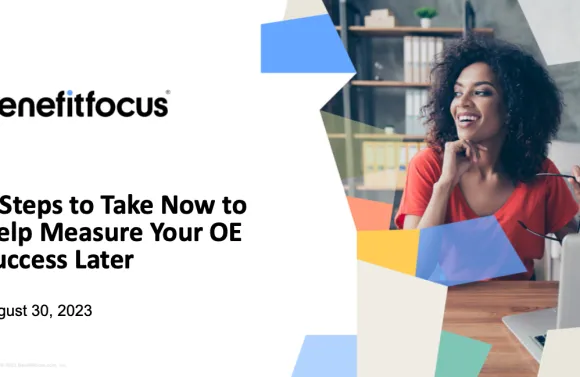
It’s no secret that engaged employees are more energized about their work, but effectively measuring employee engagement is a different story. It’s a massive topic for HR teams everywhere, especially as business leaders pay close attention to productivity levels and turnover rates in today’s market. Employee engagement goes hand in hand with both, as proven by numbers like these:
- Business teams with highly engaged employees have a 59 percent lower turnover rate than those with less engaged staff.
- Highly engaged teams are 17 percent more productive.
Of course, “what gets measured gets improved,” as world-renowned management consultant Peter Drucker says. Yet, there are so many elements of employee engagement to consider. For benefits professionals, engagement in open enrollment is a key area and a topic that’s thoroughly covered. (Explore our open enrollment resources!)
Here, we will focus on measuring employee engagement with benefits communication. Because if employees aren’t reading, watching or otherwise interacting with your communications, then you can bet they aren’t engaging with the benefits you’re pointing them to.
Measuring Employee Engagement with Benefits Communications: KPIs
Benefit teams want to understand how well their employees engage with communications and, ultimately, how that plays out in their interactions with employee benefits. But what should you measure? Where do you begin? Here are a few metrics to consider tracking:
- Open rate. Whether it’s a text message, email or newsletter, open rates show the percentage of employees opening your internal communications.
- Click-through rates. This metric shows the percentage of individuals who click on a specific link within your communication. Their clicks represent interest in the content being shared.
- Page views. While click-through rates are an essential metric, you want to know that employees viewed the content you directed them to. Page views confirm that a person landed on the destination and fully loaded after clicking on your link.
- Read time. How long did someone stay on the page? This is what read-time answers.
- Video views. You may be directing someone to a video, in which case you’d want to know how many of the total population watched the video.
Gaining Additional Insight into Benefits Communication Engagement
There are certainly other approaches for measuring employee engagement with benefits communication that aren’t tied to KPIs or metrics but are still incredibly valuable. This type of qualitative feedback can come from viewing your data differently or gathering employee sentiment on your communications initiatives.
By department
Want to look at your data in a different way? Consider finding out which teams or departments are most engaged by looking at which ones have the most opens and clicks.
You can then consider taking a deeper dive to check on what’s working before applying new strategies to other groups. Or, you can even use that information to reward the most engaged departments or incentivize those that are not.
Post-comms campaign pulse survey
There’s nothing like going straight to the source, and using employee pulse surveys is a way to do that. Pulse surveys are quick, focused surveys that typically ask a single question. The insights you gain from it can then drive meaningful employee engagement. The key is asking the right question. Here are a few examples:
- Do you feel our HR/benefits team does a good job of communicating with employees?
- Do you think it’s easy to take action on benefits communications?
- Do you feel empowered to make decisions regarding your health care (and/or finances) based on the communications you receive about employee benefits?
- Do you think the current communication tools related to employee benefits are easy to use and understand?
Learn more about employee surveys in our How to Get to Know Your People Better Playbook!
Measuring Employee Engagement with Benefits Communications in 4 Steps
Setting up a step-by-step method for measuring employee engagement with benefits communication helps you keep track of your progress and quickly bring other team members into the process as your team grows or changes.
Step 1: Evaluate past performance
Evaluate the performance of your most recent employee benefits communications and related communications initiatives. How did they perform based on the KPIs you identified? Gathering quantifiable data is an essential first step when assessing employee engagement with your benefits communication strategy. So, be sure to use data over a more significant amount of time. Rather than a two-week period, look across a three-month timeframe, for example.
Step 2: Benchmark key metrics
Now that you have your quantifiable data, it’s time to benchmark key metrics. Establish the baseline average across your data. That way, you have a clear, measurable picture of engagement rates from which you can evaluate your efforts moving forward.
Step 3: Identify opportunities for improvement
After benchmarking your key metrics, you can start to evaluate what’s going well, what might need work and pinpoint any clear drivers of engagement. And then, you can make improvements and see your success metrics improve over time.
This assessment stage may also be a perfect time to deploy a pulse survey so you can better understand what drives your employees to act or what they are looking for from you in upcoming communications campaigns. In other words, let employees tell you if there’s a better time, place or way to communicate with them about benefits.
You can also opt to take a different view, identifying what may set you up to improve employee communications about benefits in the future, such as:
- Asking yourself, “Did the HR staff have adequate time to prepare and deploy education and communication materials?”
- Investigating whether your benefits technology partners can help you leverage untapped channels (e.g., text messages) and tools to reach employees with more personalized and targeted messages.
- Examining the readability and user-friendliness of your educational and communications content.
Step 4: Act on key insights
Don’t stop at evaluation. Bring it full circle by, most importantly, acting on your insights. You’ll find better employee engagement with your benefits communication and, in turn, better results for your benefits program and overall company.
Feeling inspired to start measuring employee engagement with your benefits communications? Get more tips and ideas for making the most of your benefit communications by exploring the resources linked below:


